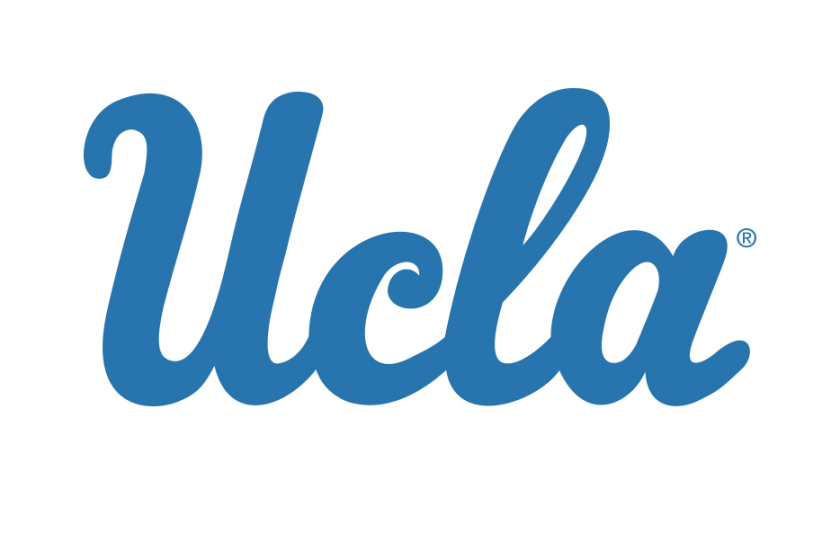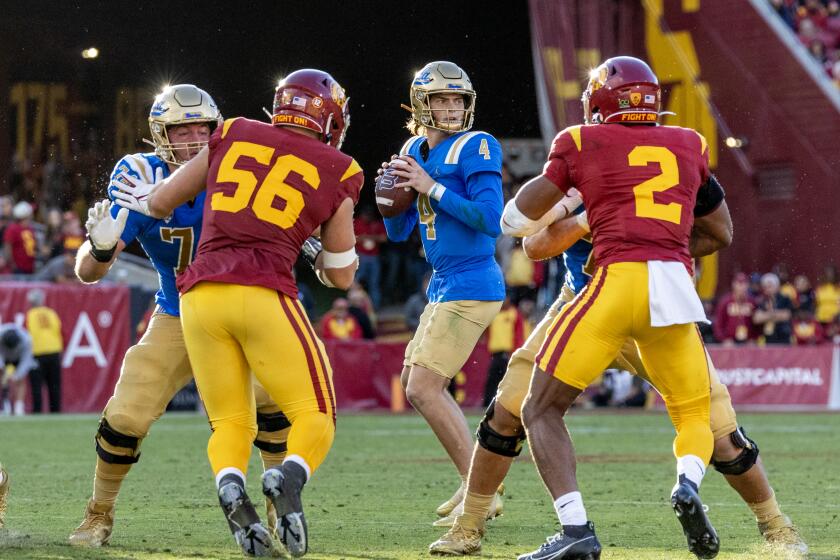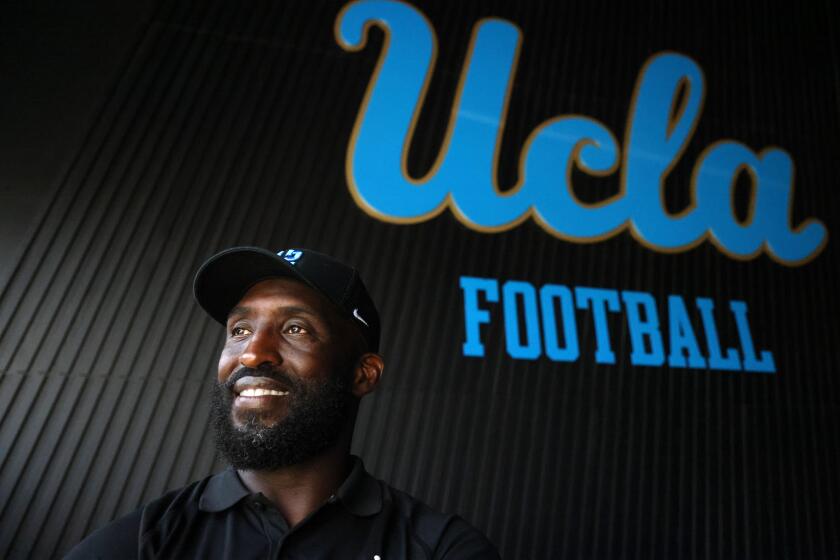Becoming a Name Performer : After Graduating From North Hollywood High, Cushing-murray Took It Slowly Until Recent Surge Propelled Him Into National Prominence in 1,500
UCLA track Coach Bob Larsen encourages his distance runners to give the 3,000-meter steeplechase a try before each season. Christian Cushing-murray took the challenge as a redshirt freshman in 1986.
Larsen believes that the steeplechase--a race that includes 28 three-foot-high barriers and seven water jumps--allows athletes to compete in meets in which that they might not have otherwise participated because of the quality of the competition in other races.
“It takes a special person to be a steeplechaser,” Larsen said. “There are those who will love it, others who tolerate it only because it might be their ticket to the conference meet, nationals or the Olympics, (and) there are other guys who don’t want to be close to the thing.”
Cushing-murray fit into the latter category. “Usually, he’ll have every athlete who runs the 1,500 on up try it in practice,” said Cushing-murray, the City Section runner-up in the 1,600 meters for North Hollywood High in 1984.
Cushing-murray went out of his way to make Larsen believe he was a poor candidate for the event.
“I would purposely exaggerate my form over the barriers and make it look worse than I actually was,” Cushing-murray said. “I would stick my right arm out when I was going over to look more uncoordinated. To this day, I don’t know if he ever knew.”
Larsen did not--and he actually was impressed with Cushing-murray’s technique. “He wasn’t too bad,” Larsen said. “Nobody twists their arm to make them run it, but he could have been pretty good at it.”
As it turned out, Cushing-murray, 23, a resident of Santa Monica now competing for the Santa Monica Track Club, has become quite adept at his preferred event--the 1,500 meters.
He has the third-fastest 1,500-meter time by an American this year, heading into The Athletics Congress outdoor championships Wednesday through Saturday in Randalls Island, N.Y.
Cushing-murray ran a lifetime-best of 3 minutes 38.81 seconds in placing third in the Santa Monica Distance Classic at Santa Monica College on May 17. Steve Scott, a three-time Olympian and the U.S. record-holder in the mile (3:47.69) won in 3:37.34, followed by Treg Scott in 3:38.61.
Cushing-murray’s mark was nearly three seconds faster than his previous best of 3:41.33, set in Barcelona last July, and also qualified him for U. S. Olympic Trials in New Orleans next summer. “I always felt I was capable of running at a high level,” said Cushing-murray.
“When I came across the finish line (in Santa Monica), I knew I had a (personal record), but I was surprised how quick it was,” said Cushing-murray, the 17th-fastest U. S. runner at 1,500 meters in 1990.
The top three finishers in the TAC meet will qualify for the U.S. team for the World Championships in Tokyo in August. Cushing-murray is also hopeful that a good showing at the TAC meet will result in product endorsements and increased appearance fees.
Cushing-murray recently resigned as a full-time instructor at Tobinworld, a private school for autistic children in Glendale, to concentrate on the TAC meet and races in Switzerland, the Netherlands, France, Switzerland and Yugoslavia this summer.
“I have committed myself to do the best I can under the circumstances,” said Cushing-murray, who married former UCLA distance runner Kathy Kiernan last month and also coaches cross-country at Windward High in West Los Angeles.
“I’ve been getting some money to run in meets, but it’s only chump change. You can probably add two or three zeros to that to give you an idea of what the big guys get. I think my real worth will be determined at the TAC meet. If I can place among the top three, I think I will be pretty close to getting by.”
As a senior at North Hollywood, Cushing-murray finished fourth in the City cross-country championships.
In track, he clipped more than 15 seconds off his 1,600-meter best in the final three weeks of the season to place second in the City finals in 4:15.07, but he failed to attract any scholarship offers and went to UCLA as a walk-on.
“I had planned to go to UCLA all along,” said Cushing-murray, whose father James and uncle Geoffrey competed on the cycling and fencing teams at UCLA. “I applied in November of my senior year and never thought about running. Running was just an afterthought and I did it because I thought it was a cool thing.”
Cushing-murray’s grandfather is responsible for the unorthodox punctuation of the surname, coming up with the idea after Cushing-murray’s great-grandmother remarried.
“From what I heard from relatives, he was a little bit eccentric and wanted to be different, so he didn’t capitalize the murray,” said Cushing-murray, who is listed as Cushing-Murray in the 1991 UCLA track and field press guide.
“I’ve given up trying to tell people not to capitalize it. I don’t even know if it is correct on my marriage license. In high school, I was always the last one filling in my name on bubble tests.”
Cushing-murray concedes that he also often brought up the rear in workouts and races his freshman year at UCLA in 1985. He failed to improve upon his high school times, running the equivalent of a 4:30 mile.
“He didn’t look too promising,” said Jim Ortiz, a teammate of Cushing-murray’s at UCLA and on the Santa Monica Track Club. “There was some talk that he might not last for his second year.”
Skipping a grade in elementary school and graduating from high school at 16 did not help matters.
“I was young for my year as it was because my birthday is in October,” the 5-foot-11, 140-pound Cushing-murray said. “I was underdeveloped and looked like I was 16 going on 14.”
Cushing-murray ran 3:47.90 in the 1,500 as a redshirt freshman in 1986 and improved to 3:46.30 as a sophomore. He finished fourth and fifth in the Pacific 10 Conference championships in 1988 and 1989, respectively.
“I knew fairly early that he had great talent,” Larsen said. “Other kids had run the types of times he ran at North Hollywood, but he was definitely going to be a four-minute miler. It was a slow process because he was so young.”
Cushing-murray’s biggest breakthrough at UCLA came in 1989 when he won the 1,500 in 3:42.81 in a double-dual meet against Louisiana State and Houston as a senior. His victory helped UCLA emerge with a 77-77 tie with LSU to preserve a 43-dual meet unbeaten streak. Texas halted the seven-year streak at 52 in March, 1991.
“We had the meet doped out that we were going to lose,” Cushing-murray said. “LSU had two other guys who had run substantially under 3:45 consistently during the season, and everybody expected them to sweep the 1,500.”
Only a week earlier, Cushing-murray had been expecting to hang up his spikes at the end of the season.
“I had just run a miserable 800 race in Florida and I was convinced that I was never going to run after college,” Cushing-murray said. “I was stuck at 3:46 or 47 for so long that I thought I had reached my limit. The 3:42 kind of rearranged my main motivation.
“I didn’t want to look back later and wonder if I could have done this or done that.” Cushing-murray credits Larsen’s conservative training philosophy for keeping him involved in the sport.
“He brought me along slowly and didn’t burn me out. It was low pressure and fairly enjoyable,” said Cushing-murray, who runs 75 to 80 miles a week under the guidance of Joe Douglas, the manager of the Santa Monica Track Club. “I am putting in a lot more quality work as well as quantity. You could train at a mediocre level, but you can only get mediocre resulte.”
The transition to the European track circuit last summer was not as gentle. Cushing-murray suffered a sprained right ankle while warming up for his first overseas 1,500 race in Lille, France.
“The ankle swelled up and there was no way I could run,” Cushing-murray said. “I was pretty upset because I had lost so much training in preparing for the meet.” Cushing-murray could only jog for the next five days and his performance (3:52.23) in the next meet in Vigo, Spain, did little to raise his confidence. A week later, he ran 3:41.33 in Barcelona, a mark that qualified him for next week’s TAC meet.
“I was relieved to qualify for something,” Cushing-murray said. “I never qualified for (NCAA) nationals or the state meet in high school. At the beginning of the trip, I wanted to run under 3:40, but I was running so badly that my goals became poorer and poorer. I just wanted to improve by a tenth of a second and come away with a (personal record).”
Douglas anticipates more improvements for Cushing-murray.
“He always has a positive aggressive attitude and I think that has helped him, especially after twisting his ankle in Europe,” Douglas said. “He has made sacrifices to make success a high priority. If he can drop one or two more seconds, he will be approaching a level where he has a chance to make the World Championships and the Olympic team.”
The biggest barriers for Cushing-murray, however, have already been overcome.
Go beyond the scoreboard
Get the latest on L.A.'s teams in the daily Sports Report newsletter.
You may occasionally receive promotional content from the Los Angeles Times.



